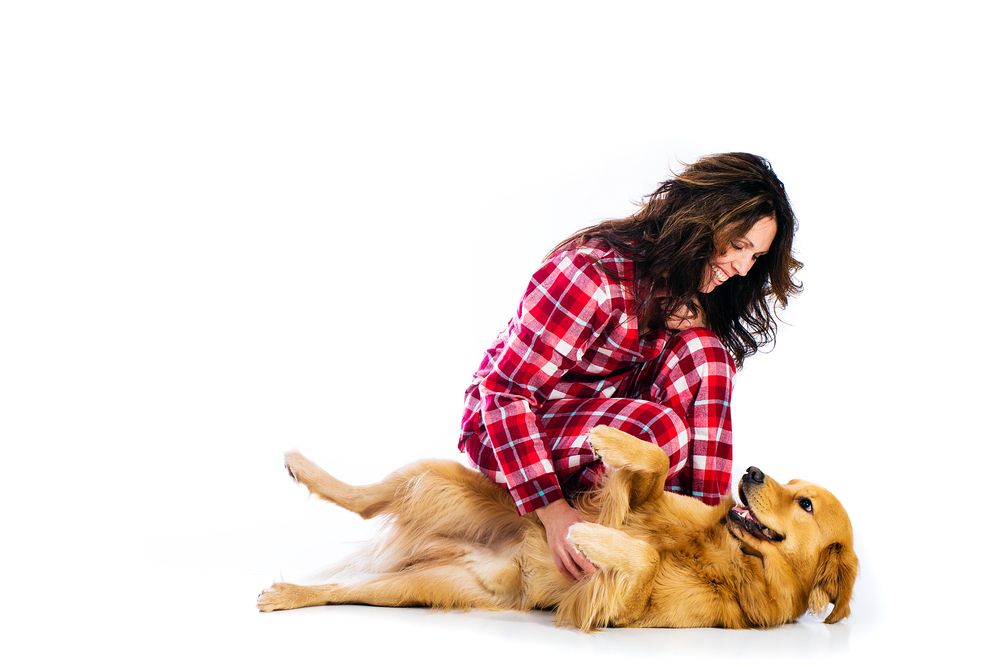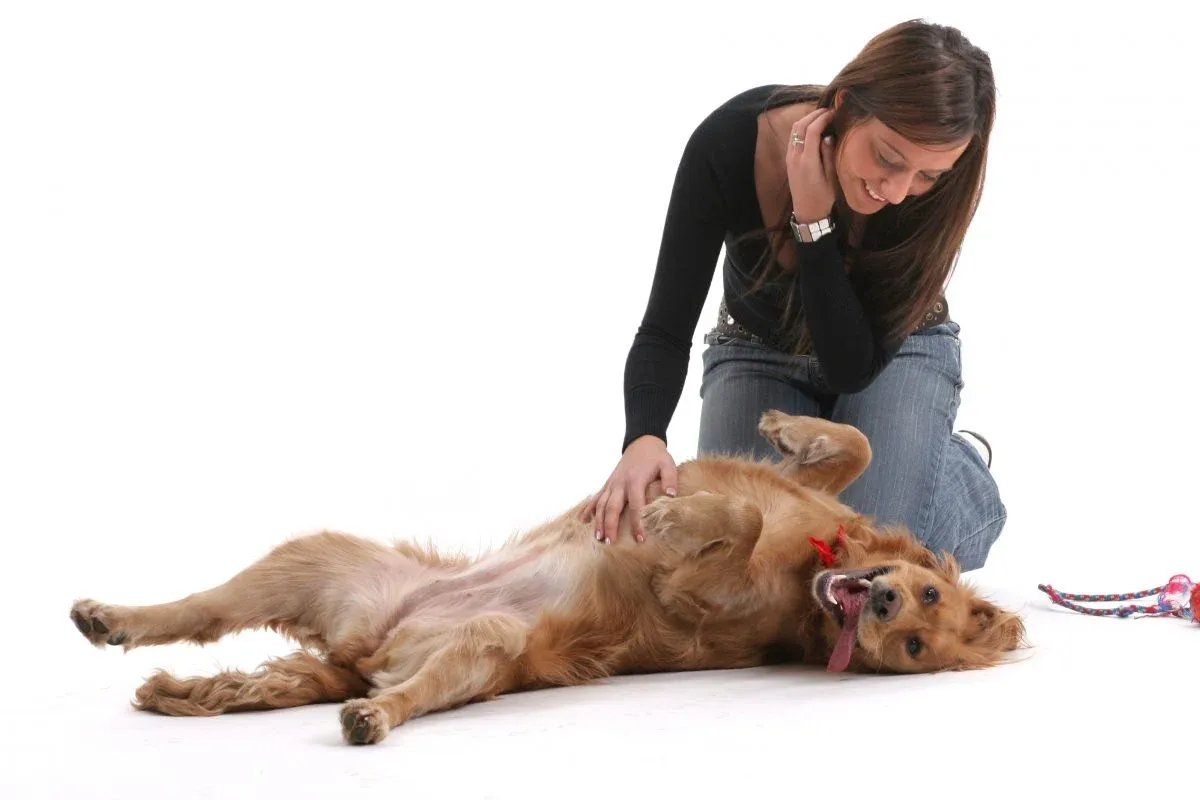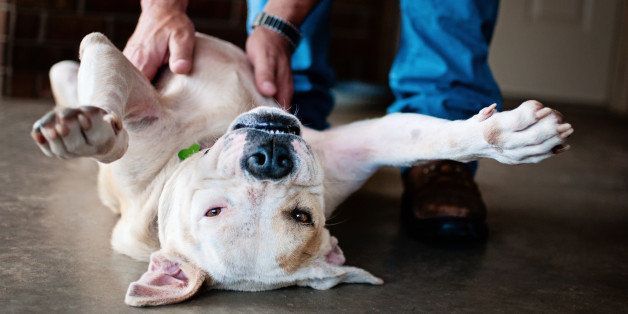Many dog owners have experienced their furry friends kicking their leg when they are scratched in certain areas. This involuntary reflex can be quite amusing but also leaves us wondering why it happens. There are a few possible reasons behind this behavior, and it is essential to understand them to better interact with our canine companions.

What Causes Dogs to Kick when Scratched?
1. Ticklish Reflexes: Just like humans, dogs can be ticklish in certain spots. When these ticklish areas are scratched, it triggers a reflexive response that leads to the kicking motion.
2. Nerve Stimulation: Scratching certain areas of a dog's body can stimulate nerves and muscles, causing them to react with a kicking movement. These areas often include the belly, the area around the back legs, and the hindquarters.
3. Pavlovian Conditioning: In some cases, dogs may have learned that when they kick or scratch a specific area, it provides relief or pleasurable sensations. Over time, this association leads to the behavior of kicking when scratched in that particular spot.

Does Kicking when Scratched Indicate Pain?
In most cases, the kicking motion when scratched is not an indication of pain. It is simply a reflex or a learned behavior that dogs exhibit. However, it is always essential to be observant of your dog's overall behavior and any signs of discomfort or pain. If you notice any other concerning signs along with the kicking motion, it is recommended to consult a veterinarian for a proper evaluation.
How to Safely Scratch a Dog
If you want to scratch your dog in a way that they enjoy and minimize any unintentional discomfort, follow these guidelines:
1. Observe the Dog's Body Language: Pay attention to your dog's body language and cues. If they seem tense, anxious or show any signs of discomfort, it is best to avoid scratching them in that area.
2. Start with Gentle Strokes: Begin by lightly scratching your dog in areas they typically enjoy, such as the base of the tail or the back of the neck. Observe their response and adjust the pressure based on their comfort level.
3. Pay Attention to the Dog's Response: Watch out for signs of discomfort or nervousness. If your happy dog pulls away, becomes restless, or shows any signs of stress, stop scratching and try a different approach to ensure their well-being.
Can Kicking when Scratched Be Trained Out of a Dog?
In most cases, this reflexive behavior cannot be trained out of a dog since it is a natural response or a learned behavior. However, training can help redirect your dog's reaction or teach them alternative behaviors to deal with certain stimuli.
When to Seek Veterinary Advice for a Dog That Kicks when Scratched
If your dog's kicking when scratched is accompanied by signs of pain, discomfort, or other abnormal behaviors, it is recommended to seek veterinary advice. A professional evaluation will help determine the underlying cause and ensure your dog's health and well-being. By understanding why dogs kick when scratched and being mindful of their responses, we can maintain a positive and comfortable interaction with our beloved furry companions.
Understanding Why Dogs Kick when Scratched
When it comes to understanding why dogs kick when scratched, there are a few key factors to consider. It's important to note that dogs kicking when scratched is a natural behavior that can vary from dog to dog.
1. Reflexes: Dogs have a reflex called the scratch reflex. This reflex causes a dog's leg to kick when a specific spot on their body is scratched or touched. The scratch reflex is an involuntary response that dogs have developed over time.
2. Itchy Sensations: Scratching certain areas on a dog's body can trigger an itchy sensation. By kicking or scratching at the same spot, dogs are trying to relieve the itch or discomfort they are feeling.
3. Nerve Stimulation: Scratching certain areas can also stimulate the nerves in a dog's body, which can lead to a feeling of relief. This can explain why dogs may kick or scratch even more when they are scratched in specific areas.
4. Positive Association: Dogs may also kick when scratched because they have associated the feeling of being scratched with a positive experience, such as receiving attention or affection from their owners. This positive association encourages them to continue kicking or scratching.
To further illustrate this behavior, here's a true story: I have a Labrador Retriever named Max. Whenever I scratch behind his ears, he immediately starts kicking his leg in response. It's a reflex that he has developed, and it's always amusing to watch. Max clearly enjoys the sensation of being scratched, and the kicking is his way of showing his pleasure. It's a unique behavior that adds to his charm and personality. So, next time you see a dog kicking when scratched, remember that it's a natural behavior and a sign that they're enjoying the moment!
What Causes Dogs to Kick when Scratched?
Have you ever wondered why dogs kick when you scratch certain spots? Let's dig into what causes this adorable yet curious behavior. We'll explore the intriguing connection between ticklish reflexes, nerve stimulation, and even Pavlovian conditioning. Get ready to uncover the fascinating reasons behind why dogs kick when scratched!
Ticklish Reflexes
- Dogs have ticklish reflexes that can cause them to kick when scratched.
- These reflexes are a natural response to certain stimuli on their skin.
- Ticklish reflexes occur because dogs have a heightened sensitivity in certain areas of their bodies.
- Areas such as their belly, armpits, and back legs are particularly prone to ticklish reflexes.
- When these areas are stimulated, it can trigger a ticklish sensation that makes them kick.
- This response is similar to humans laughing or pulling away when tickled.
- It is important to note that not all dogs have the same level of ticklish reflexes.
- Some dogs may have a more intense reaction, while others may barely react at all.
- Ticklish reflexes can vary depending on the individual dog's sensitivity and past experiences.
- While ticklish reflexes are generally harmless, it is crucial to observe your dog's body language and response to ensure they are comfortable and not in any pain.
Nerve Stimulation
- Nerve stimulation is one of the factors that can cause dogs to kick when scratched.
- When a dog is scratched in certain areas, it can trigger a response in the nerves located in that particular region.
- The nerves send signals to the muscles, resulting in a reflexive kicking motion.
- This nerve stimulation can be more pronounced in certain dogs and can vary depending on the individual dog's sensitivity.
- It is important to note that not all areas of a dog's body will elicit a kicking response through nerve stimulation.
- Common areas that are more likely to trigger a kicking response include the belly, the hindquarters, and the back legs.
- When scratching a dog, it is important to be aware of these areas and observe the dog's response for signs of discomfort or sensitivity.
- It is also worth noting that nerve stimulation through scratching can vary in intensity, with some dogs displaying a gentle twitch while others may have a more pronounced kicking motion.
- Understanding the role of nerve stimulation can help in safely scratching a dog and avoiding any potential discomfort or negative reactions.
- If a dog consistently exhibits a strong kicking response or shows signs of pain during scratching, it is advisable to consult a veterinarian to rule out any underlying health issues.
Pavlovian Conditioning
Pavlovian Conditioning plays a significant role in understanding why dogs kick when scratched. This type of conditioning refers to the process of associating a stimulus with a specific response through repeated exposure. In the case of dogs kicking when scratched, it can be attributed to a conditioned reflex.
When a dog is scratched in a certain area repeatedly, it starts associating the sensation with a specific action, such as kicking its leg. This response is not a conscious decision by the dog but rather a learned behavior through Pavlovian Conditioning. Over time, the dog's brain forms a connection between the scratch and the leg movement, leading to the automatic kicking response.
It is important to note that Pavlovian Conditioning is not limited to scratching. Dogs can develop conditioned reflexes in various situations, such as associating the sound of a can opener with getting food or the ringing of a doorbell with someone arriving at the door.
Understanding the role of Pavlovian Conditioning can help dog owners comprehend why their pets exhibit certain behaviors. By recognizing this, owners can provide appropriate training and create positive associations to eliminate unwanted responses, if desired. It is essential to consult with a professional dog trainer or a veterinarian before attempting to modify a dog's behavior through Pavlovian Conditioning techniques.
Pavlovian Conditioning plays a significant role in understanding why dogs kick when scratched. Through repeated exposure, dogs develop conditioned reflexes that result in automatic leg movements when scratched in certain areas.

Does Kicking when Scratched Indicate Pain?
When a dog kicks when scratched, it does not necessarily indicate pain. Dogs have various ways of expressing their discomfort or pleasure, and kicking when scratched is often a sign of pleasure rather than pain. This behavior is known as the scratch reflex, which is an involuntary response to a sensory stimulus.
The scratch reflex is a natural response for dogs when their skin is stimulated, causing them to kick their leg as a reflex action. This behavior is similar to humans experiencing a ticklish sensation. It is a normal and instinctive reaction, and it does not necessarily indicate any pain or discomfort.
To understand if a dog is in pain, it is important to consider other signs and behaviors exhibited by the dog. Signs such as whining, limping, decreased appetite, or changes in behavior are more indicative of pain in dogs.
If a dog shows signs of pain along with kicking when scratched, it is still essential to consult a veterinarian to properly assess the dog's condition. A professional opinion can help determine if there is an underlying issue causing the pain and provide appropriate treatment.
Kicking when scratched in dogs does not necessarily indicate pain. It is important to be observant of other signs and behaviors to accurately assess a dog's well-being. Consulting a veterinarian is always advised when concerned about a dog's health.
How to Safely Scratch a Dog
When it comes to scratching our furry friends, ensuring their comfort and safety is paramount. In this section, we'll uncover essential tips for safely scratching a dog. From observing their body language to starting with gentle strokes, and paying close attention to their response, we'll explore the best practices that will keep both you and your canine companion happy. Get ready to delve into the art of dog scratching and discover how to create those moments of pure bliss for your canine companion.
Observe the Dog's Body Language
Observing the dog's body language is crucial when scratching them. By paying attention to their movements and behaviors, you can ensure a safe and enjoyable experience for both you and the dog.
- Look for signs of relaxation: If you observe the dog's body language and see that they are comfortable and enjoying the scratch, they may exhibit relaxed body language. Their muscles may appear loose, and they may lean into the scratching motion. A wagging tail and a soft expression are also positive indicators.
- Beware of signs of discomfort or stress: If you observe the dog's body language and notice that the dog tenses up, pulls away, or shows signs of separation anxiety, such as lip licking or yawning, it's important to stop scratching immediately. These cues indicate that the dog may not be enjoying the interaction and continuing could cause distress.
- Pay attention to their ears and tail: By observing the dog's body language, specifically their ears and tail, you can gather important information. If you notice the dog's ears are pinned back or their tail is tucked between their legs, it could be a sign of discomfort or fear. On the other hand, if their ears are perked up and their tail is wagging, it suggests that they are enjoying the experience.
- Take note of their vocalizations: By observing the dog's body language and listening to their vocalizations, you can gain insights into their feelings. Some dogs may make happy sounds like soft whines or sighs when they're being scratched in a way they enjoy. However, if the dog starts growling or yelping, it's a clear sign that the scratching is causing pain or discomfort.
By observing the dog's body language, you can ensure that the scratching experience is positive and enjoyable for both you and your furry friend.
Fact: Dogs communicate primarily through body language, so by observing the dog's body language, we can understand their cues better and strengthen the bond between humans and dogs, ultimately improving their overall well-being.

Start with Gentle Strokes
When it comes to scratching a dog, it's crucial to start with gentle strokes to ensure their comfort and well-being. Here are some steps to follow:
- Approach the dog calmly and slowly.
- Use a soft touch and gentle pressure with your hand.
- Start with gentle strokes on areas like the back or the base of the tail.
- Observe the dog's reaction to ensure they are enjoying the scratching.
- If the dog seems relaxed and happy, you can gradually increase the pressure.
- Continue to monitor the dog's body language and adjust your strokes accordingly.
- Avoid scratching and licking sensitive areas such as the belly or ears without knowing the dog's preferences.
- If the dog shows signs of discomfort, like moving away or stiffening, stop scratching immediately.
- Remember that every dog is different, so be sensitive to their individual needs and preferences.
Throughout history, humans and dogs have formed a special bond, with scratching and petting being a way to show affection and establish a connection. By starting with gentle strokes, we can create a pleasant experience for both the dog and ourselves, ensuring a harmonious interaction. This gentle approach helps to cultivate trust and enrich the overall well-being of our furry friends, enhancing our relationship with them. So, the next time you want to scratch a dog, remember to start with gentle strokes and pay attention to their cues for a rewarding and enjoyable experience.
Pay Attention to the Dog's Response
When scratching a dog, it is crucial to pay attention to the dog's response to ensure their comfort and enjoyment. Here are some steps to follow:
- Observe the dog's body language: Before you start scratching, take note of the dog's overall demeanor. Look for signs of relaxation, wagging tail, or leaning into your touch. These are indications that the dog is enjoying the scratching.
- Start with gentle strokes: Begin scratching the dog in a gentle manner to gauge their response. Pay attention to how they react. If they lean into the touch or show signs of relaxation, you can continue with more pressure.
- Pay attention to the dog's response: As you scratch, closely observe how the dog reacts. Pay attention to any signs of discomfort or unease, such as pulling away, tensing up, or growling. If the dog shows any signs of discomfort, stop scratching immediately.
It is vital to pay attention to the dog's response during scratching as it allows you to ensure their well-being and avoid causing any distress. By observing their body language and adjusting your touch accordingly, you can provide a pleasant and enjoyable experience for your furry friend.
When to Seek Veterinary Advice for a Dog That Kicks when Scratched
When your dog kicks when scratched, it may indicate the need for veterinary advice. Here are some situations when seeking veterinary advice is recommended:
1. Persistent or worsening behavior: If your dog's kicking behavior becomes more frequent or intense, it is advisable to seek veterinary advice. This could be a sign of an underlying medical condition or discomfort.
2. Physical injuries: If your dog's kicking leads to injuries such as broken nails, bleeding, or open wounds, veterinary attention should be sought. Proper medical treatment and care can prevent infection and promote healing.
3. Changes in behavior or temperament: If your dog's behavior changes when being scratched, such as displaying aggression or fear, it is important to consult with a veterinarian. These changes could be an indication of pain or discomfort.
4. Persistent itching or irritation: If your dog constantly exhibits scratching behavior, along with kicking, it may indicate a skin condition or allergies. Seeking veterinary advice can help identify the underlying cause and provide appropriate treatment.
5. Unusual kicking patterns: If your dog only kicks in specific areas or in response to certain types of scratching, it is recommended to consult with a veterinarian. This can help determine if the behavior is related to a specific medical issue.
Remember, each dog is unique, and seeking veterinary advice can ensure the well-being and health of your pet. Early intervention and proper medical care can help address any issues and improve your dog's comfort and quality of life.
Some Facts About Why Dogs Kick When Scratched:
✅ Dogs often kick their back leg when their belly is scratched, known as the "sweet spot." (Source: Our Team)
✅ The kick reflex is an involuntary reaction similar to the knee-jerk reflex in humans. (Source: Our Team)
✅ It is an uncontrollable and involuntary reflex that causes dogs to kick out and scratch with their hind legs when nerve endings on the skin are stimulated. (Source: Our Team)
✅ The scratch reflex can be triggered by parasites, insects, or other irritations on the skin, as well as human petting, brushing, and playing with other animals. (Source: Our Team)
✅ The scratch reflex is a form of protection against parasites and bugs, as it helps dogs get rid of them. (Source: Our Team)

Frequently Asked Questions
Why does my dog kick when I scratch their belly?
When you scratch your dog's belly, it activates nerve endings in their skin, causing their leg to kick. This is known as the dog scratch reflex, which is a biologically inbuilt reflex to dislodge potential irritants like ticks and fleas.
What is the scientific reason behind the dog scratch reflex?
The dog scratch reflex is an automatic response to stimuli on the skin. It is designed to ensure the dog's survival by dislodging potential parasites or irritants. When you scratch a specific area of a dog's belly, it triggers nerve endings that send a message to their leg to kick.
Is the dog scratch reflex similar to the knee-jerk reflex in humans?
Yes, the dog scratch reflex is an involuntary reaction similar to the knee-jerk reflex in humans. Just like how the knee-jerk reflex doesn't involve the brain, the scratch reflex in dogs doesn't require any conscious thought or involvement from the dog.
Is it normal for a dog to kick their back leg when their belly is scratched?
Yes, it is completely normal for a dog to kick their back leg when their belly is scratched. This particular spot is often referred to as the "sweet spot" and activates the dog scratch reflex. It startles the dog, similar to a bug landing on their nose.
Can constant scratching be a sign of an underlying medical cause?
Yes, constant scratching can be a symptom of various medical conditions such as fleas, ticks, allergies, or sarcoptic mange. If your dog is excessively scratching or kicking, it is important to seek advice from a veterinarian to rule out any underlying medical problems.
Is it safe to continue scratching my dog's belly if they enjoy it?
Yes, if your dog enjoys belly scratching, it is safe and actually encourages positive behavior and mental enrichment. Pay attention to your dog's body language and behavior to determine if they enjoy the sensation or not. However, if your dog tries to move away or shows signs of discomfort, they likely want the scratching to stop.




